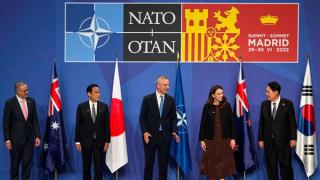Last week’s NATO summit will be remembered as historic for a number of reasons, most of all for having unveiled the new “Strategic Concept” for the alliance that was said to be searching for purpose.
The Madrid meeting showed that NATO found its purpose in its “factory settings” of defence and deterrence on its eastern borders. Therefore, the promise of deepening its partnership with Australia and three other countries from the region, which was also one of the takeaways from the summit, will largely depend on the security developments in the Euro-Atlantic area.
The new Strategic Concept delivered an assessment of a much more adversarial international environment and set out a vision for at least the next decade. Although the document makes it clear the 30-member-strong alliance is attuned to the challenges from outside its core geographical and functional areas, it will be looking much closer to home for at least some time, given Russia’s aggression in Ukraine and threats to NATO’s eastern flank.
The fact the Indo-Pacific region received a mention for the very first time in NATO’s strategic communication, and Australia implicitly got called upon as a partner that will be crucial in enacting the alliance’s strategic ambitions, should not be underestimated.
The fact the Indo-Pacific region received a mention for the very first time in NATO’s strategic communication, and Australia implicitly got called upon as a partner that will be crucial in enacting the alliance’s strategic ambitions, should not be underestimated. However, it needs to be properly contextualised.
The 2022 Strategic Concept is the culmination of NATO’s self-reflection, and it stands in sharp contrast to the last time the alliance engaged in such an exercise twelve years ago.
There are several external and internal factors that have precipitated a major change. From the diffusion of power and threats to international security away from the Euro-Atlantic area and away from the nation-states in general, to the internal jolts that ranged from French President Emmanuel Macron’s that quip the alliance was “brain-dead” to the former US president Donald Trump’s frequent rails against the transatlantic allies.
Launched in 2019, the NATO 2030 initiative was one of the more recent institutional responses to help make the alliance more responsive to the changed strategic realities. As a result, some of the more recent NATO summits and meetings introduced a panoply of new threats and challenges in their communiques and statements. To some, this was a symptom of NATO’s search for purpose as a Cold War relic in the 21st century. For instance, China was included on the list of challenges to the alliance in 2019, while the talk of non-state based threats started featuring issues such as climate change.
Doubling down on its original mission
The expectation was that the Madrid summit would deliver a Strategic Concept that would go beyond NATO’s core geographical and functional areas of concern. However, Russia’s invasion of Ukraine in February and the ensuing war have brought NATO’s core mission – that of defence and deterrence in the North Atlantic area – back into the forefront. This in turn prompted a debate about the extent to which NATO would double down on its original mission, or whether it would also be able to respond to the security challenges emanating from the Indo-Pacific.
The new Strategic Concept wrestles with this debate. There is no doubt peace and stability within the NATO borders and around its neighbourhood remain the top priority. The allied states have committed to an unprecedented increase in the number of troops and equipment deployed to NATO’s eastern borders, opening of new military bases, and imminent growth as it prepares to welcome Finland and Sweden into the fold.
At the same time, NATO has signalled its ambition to respond to the threats and challenges beyond the Euro-Atlantic area. Australia’s engagement with NATO has to be viewed in this light.
All parties are invested in similar strategic goals as they prioritise defending the rules-based order, addressing the traditional and emerging security challenges, and working on countering disinformation and building societal resilience.
For at least two decades now, mostly in the context of the ISAF mission in Afghanistan, NATO has made crisis management and co-operative security two of its other core tasks. NATO’s partnerships such as that with Australia have been crucial in undertaking those tasks. The new Strategic Concept places an emphasis on enhancing the existing partnerships.
Australia is often referred to as a “special partner” given it possesses significant capabilities and can act as a security producer rather than a consumer. In its dealings with NATO it is increasingly grouped in the so-called “Asia-Pacific Four” (AP4) along with Japan, New Zealand and South Korea. Although this was not the first time leaders from the AP4 have attended NATO’s meetings, and there is no talk of expanding the alliance all the way to the other side of the world, there has been plenty of discussion about how the AP4 and NATO can collaborate to their mutual benefit.
There is no lack of ambition when it comes to the potential co-operation between NATO and the AP4. All four countries have bilaterally negotiated partnership documents with NATO and are in the process of having them renewed to make the co-operation even more meaningful. Since 2019, the year China appeared on NATO’s summit communique for the first time, NATO has included the AP4 much more regularly into relevant NATO meetings at all levels.
In fact, the representatives of the AP4 have all been consulted on what the 2022 Strategic Concept would include. There is no doubt the alliance considers security in the Indo-Pacific as having a direct bearing on the transatlantic security.
All parties are invested in similar strategic goals as they prioritise defending the rules-based order, addressing the traditional and emerging security challenges, and working on countering disinformation and building societal resilience.
These are all steps in the right direction since the strategic interests and values that bind NATO allies extend beyond the Euro-Atlantic area and apply to the AP4. Yet, the adage of it being “too early to tell” still stands. Much will depend on the inputs and urgency from all parties involved to see the concrete results of cooperation.
For the time being, while there is a recognition that the Indo-Pacific is in the long-term a more important theatre, the acuteness of security crisis in Eastern Europe makes it hard to divert attention and resources away. A boon for transatlanticists, and a source of frustration for the Indo-Pacific watchers.






